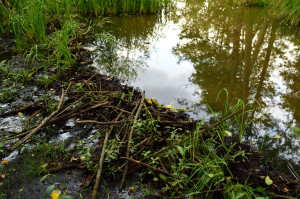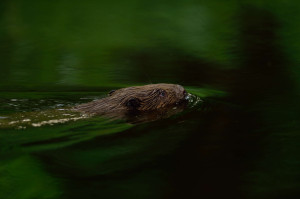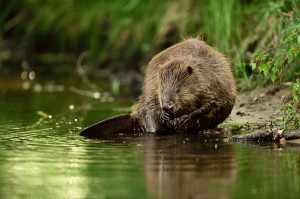Well-known German wildlife photographer Solvin Zankl is on a photo mission for Rewilding Europe in the Oder delta. Here is his update from the field.
caption id=”attachment_7221″ align=”aligncenter” width=”690″] Peene river and flooded lands near Anklamer Stadtbruch, Germany[/caption]
Peene river and flooded lands near Anklamer Stadtbruch, Germany[/caption]
The Oder river delta is one of Europe’s less known wildlife areas. It is an estuary area, or an inland delta and lagoon, where the rivers Oder and Peene flows out into the Baltic Sea. The Oder river is also the border between Germany and Poland.
The Oder delta, like most delta lands, is pretty flat and lacks hills and mountains. Instead, it offers wide reed beds, wet grasslands, bogs, moors, swamp forests and lots of small waterways. Whoever intends to explore this area is well advised to use a canoe – and this is exactly what I am up to, because my mission is to take pictures of beavers. The Peene lowlands offer the best conditions for that in the area. In 1973 a small group of beavers was brought here from the Elbe river in Germany to reintroduce the species in thius area, where it had once been common. Todays numerous and unmistakable beaver tracks tell the success story of that project. Beavers are now found pretty much everywhere in the area.

Since the many riverbanks here are very rich in vegetation, the beaver finds plenty of food at lower levels and doesn’t have to cut as many trees as in other areas where beavers live, for feeding. However, the animals of course use plenty of wood for their homebuilding activities: numerous beaver dams and beaver lodges can be found. This is also one of the reasons for why the existence of beavers in an area immediately bring more biodiversity: they create many more small areas with standing water in the forest and they open up certain areas so that sunlight can reach down, which is appreciated by a myriad of life forms.
So I expected it to be pretty easy to find and photograph these famous builders themselves. However, I had to learn that due to the huge home range of each individual beaver the chances for me to be waiting for it at the right spot are rather small. Beavers are in many areas mainly nocturnal animals, they are most active at night.

Luckily for us photographers though, some come out a bit „earlier“ than the others, already at the first signs of dusk. These individuals are the ones the photographer needs to find, in order to have a chance of taking good pictures. It takes me a couple of evenings to find the right spot and a “good” beaver, but finally I have positioned myself and my camera gear behind a tree that has been spared from the beaver’s teeth so far.
My hiding spot is actually so well chosen and I am so well camouflaged, that the beaver calmly passes by only half a meter away – which is far too close to take any picture with the 400 millimeter lens that I was planning to use! But when the beaver finally climbs the riverbank side, dripping wet, it acts as I had hoped for, shaking the water out of its thick fur at the right photo distance from me.

I get a bit of a wet beaver-breeze, but have to concentrate on making best use of the situation. The sunset limits my time to take pictures and at the same time I have to act cautiously and not make too much noise. Because then the beaver might simply leave and use one of its numerous other haul-out spots. Luckily, all goes well – the beaver feeds on fresh birch leaves for a while and later waddles on along its waterway, towards new places to be and other things to do.
I will be back here tomorrow, hoping to meet „my“ beaver again.
Take a look at the gallery below to see Solvin’s other photographic encounters in the area:
